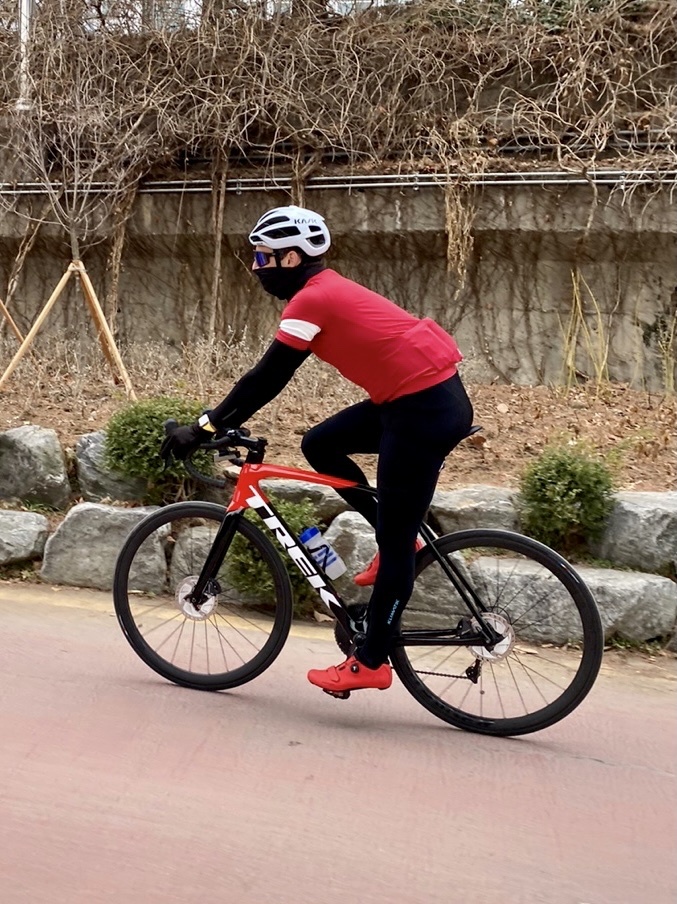 |
The pandemic-fueled cycling boom appears to continue this year as sales of bikes and cycling clothes are on the rise. |
From going out late at night to traveling abroad, the coronavirus pandemic has prevented us from doing many things we love -- except for cycling.
On the weekend, serious cyclists with racing bicycles and more casual riders on Seoul Bikes mingle on the cycling lanes alongside the Han River in Seoul which cuts through the city and stretches nearly 500 kilometers.
Kim Tae-gyun, a 37-year-old marketing director and a former PE teacher in Seoul, said cycling has become his go-to exercise as of late.
“I gained a lot of weight during the coronavirus pandemic and as someone who used to teach PE, I began working out at home. But it felt suffocating. Now I mainly cycle.”
Kim says the appeal of cycling comes down to freedom.
 |
Kim Tae-gyun, a 37-year-old marketing director and a former PE teacher, regularly enjoys cycling. (Instagram account @kotaliano_) |
“You are free, not restricted by time or place. You don’t need to have a partner or have to keep the tempo with others. You can cycle anywhere as long as your stamina allows,” he said.
The popularity of the two-wheeled vehicle remains strong nearly a year into the pandemic in South Korea, with sales of bikes and cycling clothes on online marketplace Gmarket seeing a 9 percent and 12 percent year-on-year jump, respectively, in the first two months of 2021.
For the whole of last year, Gmarket saw a 13 percent jump in overall sales volume of bikes.
Standard bicycles, including utility and city bicycles, enjoyed a 24 percent year-on-year increase in sales while mountain bikes and Mini Velo bikes saw their sales rise by 15 percent and 38 percent, respectively.
Cycling clothes saw an even bigger jump, up 53 percent over the same period, while sales of bibs and shorts rose by a whopping 136 percent.
The city’s bike rental service known as Seoul Bikes or “Ttareungyi” also saw a 24 percent year-on-year increase in usage last year as they emerged as a pandemic-safe mobility alternative to public transport, according to the Seoul Metropolitan Government. The service racked up 2.78 million users by the end of last year, which accounts for nearly 1 in 4 residents in the capital.
Joe Maloney, a 34-year-old English teacher from the United States who has lived in Seoul for eight years, took up cycling with Ttareungyi in the middle of the pandemic last year. Now he rides his own.
 |
Joe Maloney, a 34-year-old English teacher, took up cycling during the pandemic. (Instagram account @joemaloneyjoe) |
“Last year I needed some relief, some mental health outlet, so I bought a bike. I actually started because I was taking the Ttareungyi bikes. Then I craved a little bit more,” Maloney said.
“I’ve lived in Seoul for eight years but I’m experiencing it in a totally new way because I’m not stuck on a train or a bus. I can sort of have agency about where I go. Anywhere my bike can go, I can go.”
From a quick ride around Namsan Park to a longer trip along the Han River and all the way to Hanam in Gyeonggi Province to the east of Seoul, Maloney says keeping track of his record through sports apps like Strava helps keep him going.
“I find tracking my progress on Strava and seeing personal records for certain segments to be really motivating, seeing how I get faster over time,” he said.
The newfound interest in cycling boosted sales at Samchuly, South Korea’s largest bicycle manufacturer and retailer. Sales volume of Samchuly bikes increased 37.5 percent year-on-year in 2020.
One official at the company explained last year’s sales jump bucked the trend seen in the last few years of a declining overall sales volume.
“Demand for bikes grew in part as exercising indoors became difficult but it was also affected by the people who avoided public transport and used bikes to commute to work or school. As schools shut down, children looked for entertainment and that also drove up the demand,” the official said.
Though bikes for regular use account for a bigger portion of sales, high-end models are also gaining ground when it comes to enjoying cycling as a sport.
“Though the surge in popularity affected models across the board last year and this year so far, Cello’s entry-level high-end road and mountain bikes are gaining popularity in particular,” the Samchuly official said.
Why cycling is the perfect pandemic sport
Shim Kyung-won, professor of family medicine at Ewha Womans University Seoul Hospital, says cycling is the perfect hobby to take up during this pandemic for all age groups.
“Cycling is one of the sports I recommend to obese patients and patients with diabetes,” Shim said.
“Walking is the easiest exercise since you don’t need anything to take part, but it might not be the best choice for people with weak joints. Cycling, however, is easy on the joints and consumes a great deal of energy compared to how tough it feels. It helps with losing belly fat and strengthening the thigh muscles.”
For senior age groups, especially, it was a sport that would produce the least amount of side effects, she added.
The health benefits of cycling go beyond the physical, which comes in handy at a time when many people are experiencing deteriorating mental health.
According to data from the Ministry of Health and Welfare of South Korea, the number of consultations for anxiety disorders received through its mental health centers rose by 44.8 percent during the first half of 2020, from 13,067 to 18,931 cases.
A recent report from Hana Institute of Finance also showed that money spent at neuropsychiatry clinics between January and October last year was up 14 percent from the same time one year ago.
“You can exercise on a stationary bike but it’s better to get sunlight and get vitamin D which helps strengthen your immune system against respiratory diseases,” Shim said.
“You can enjoy being in the fresh air and get sun exposure which produces serotonin and helps shake off depression that comes from staying home all day long,” she said.
By Yim Hyun-su (
hyunsu@heraldcorp.com)










![[Today’s K-pop] Blackpink’s Jennie, Lisa invited to Coachella as solo acts](http://res.heraldm.com/phpwas/restmb_idxmake.php?idx=644&simg=/content/image/2024/11/21/20241121050099_0.jpg)